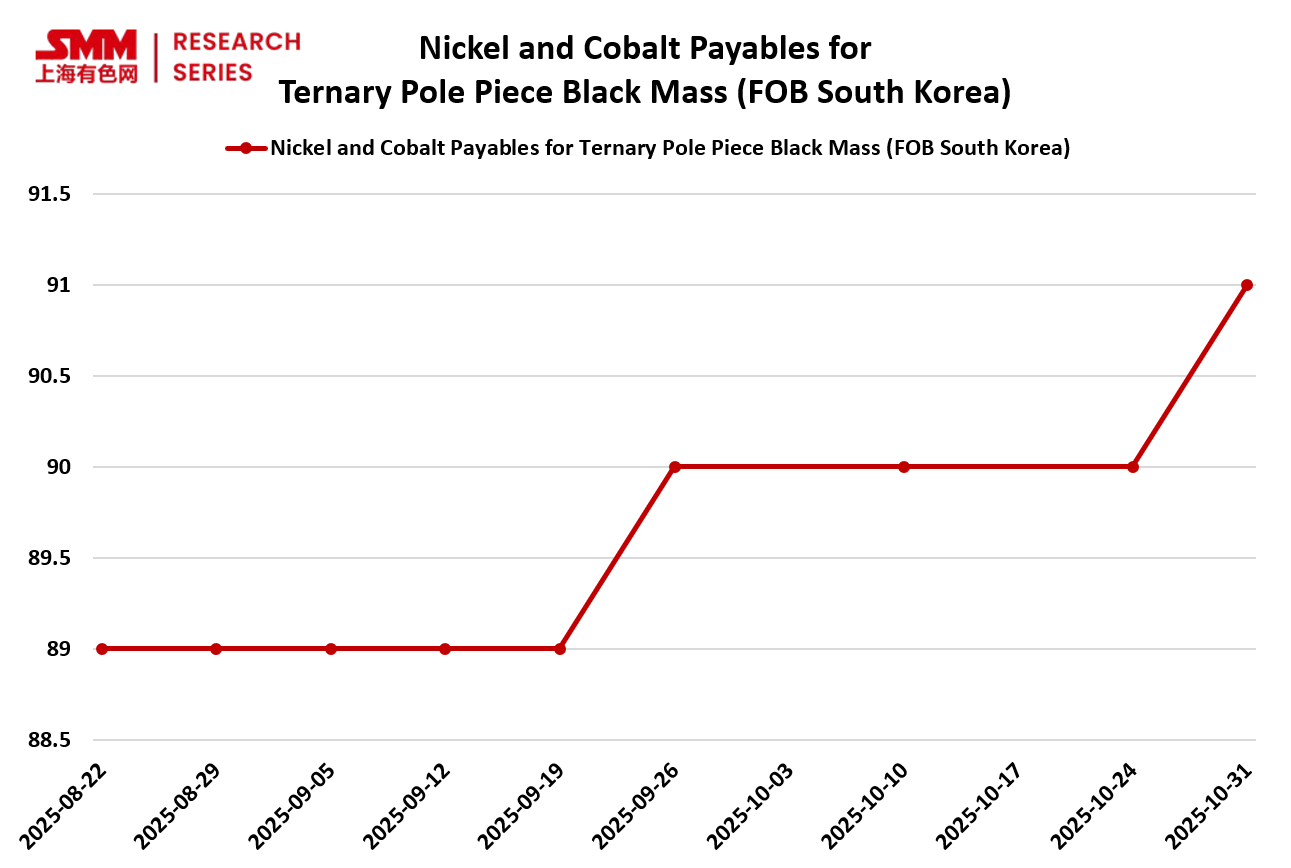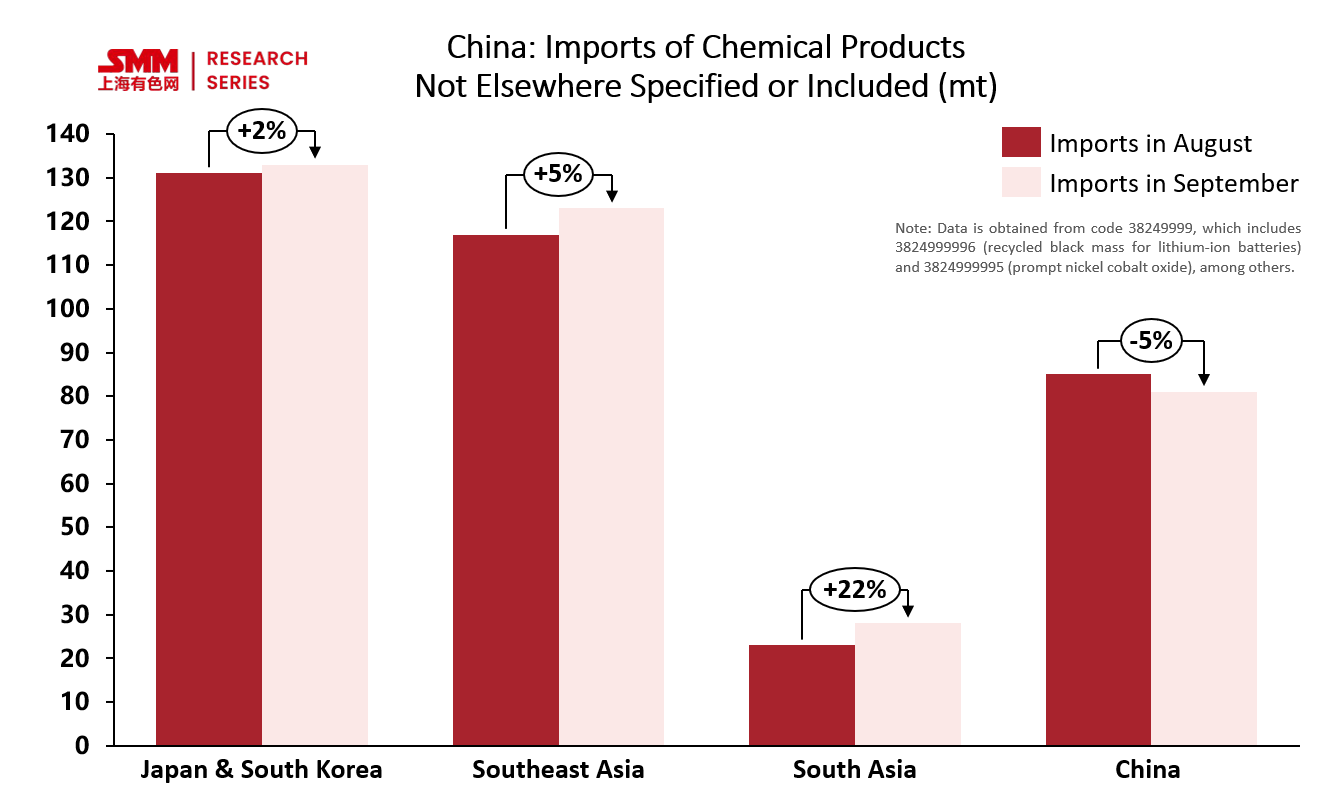






SMM Analysis: In Q3 2025, the FOB South Korea nickel and cobalt payables for ternary pole piece black mass remained generally stable, but regional price spreads gradually narrowed; at the same time, an increasing trend in imports by Japan and South Korea and Southeast Asia emerged simultaneously, indicating a restructuring of cross-border flows, with Southeast Asia gradually becoming a key period for intermediate product processing and re-export.
I. FOB South Korea Nickel and Cobalt Payables for Ternary Pole Piece Black Mass Strengthened Amid Stability, Overseas Demand Drove Price Recovery
By month-end October, the FOB South Korea nickel and cobalt payables for ternary pole piece black mass held within the range of 89–93, up approximately 2 coefficients compared to mid-August, showing a steady yet rising overall price performance. Market feedback indicated that the overseas shipment pace slowed down slightly recently, but transaction prices remained firm, reflecting continued support for mid- to high-nickel raw material demand.

Chart 1: FOB South Korea Nickel and Cobalt Payables for Ternary Pole Piece Black Mass Trend, August–October 2025
As shown in Chart 1, from late August to month-end October 2025, the FOB South Korea nickel and cobalt payables for ternary pole piece black mass exhibited an overall trend of stability with slight increases. From late August to mid-September, the payables remained around 89, with relative market stability during this period, mainly influenced by high inventory levels at recycling plants in Japan and South Korea and delayed order scheduling by some exporters, resulting in limited trading activity. Entering late September, the FOB payables saw the first increase to 90, with some South Korean recycling plants reporting a gradual recovery in domestic demand for mid- to high-nickel scrap and increased inquiries from downstream for high-grade pole piece black mass. By month-end October, offers rose further to 91, hitting a nearly two-month high.
The pace of price changes corresponded to supply-demand characteristics. High inventory at recycling plants in Japan and South Korea and delayed order scheduling by exporters led to fewer transactions from August to mid-September; after late September, recovering domestic demand for mid- to high-nickel scrap pushed offers upward; by month-end October, prices stabilized and recovered, indicating strengthening price linkage across regions.
Overall, the rise in FOB South Korea nickel and cobalt payables for ternary pole piece black mass reflects a phased recovery in high-nickel recycling raw materials. With raw material structure adjustments in the Southeast Asian market and recovering downstream demand, prices are expected to remain firm in the short term.
II. Asian Black Mass Imports Rebounded, Southeast Asia’s Transit Role HighlightedChart-2: Black Mass Imports Distribution, August-September 2025

Chart-2: Black Mass Imports Distribution, August-September 2025
Note: Data was obtained from code 38249999, which includes 3824999996 (recycled black mass for lithium-ion batteries) and 3824999995 (crude nickel-cobalt hydroxide), among others.
Since August, with China lifting restrictions on imports and exports of qualified overseas black mass, new shifts have emerged in black mass flows within the Asian market. At the same time, retired batteries from Europe and North America are accelerating their flow into Southeast Asia and South Korea, providing stable support for regional black mass supply. The trends in the Japanese and South Korean markets have diverged from those in China. Japan and South Korea, benefiting from mature technology and relatively sufficient inventory, maintained high import volumes, though growth slowed down. In China, September imports remained at around 800 mt, indicating resilient domestic procurement demand for overseas intermediate products. Currently, the total black mass processing capacity in Asia is approximately 2.5–3 million mt per year. Some domestic enterprises continue to show active purchasing interest in categories such as ternary pole piece black mass and LCO, supporting overall import stability.
III. Conclusion
Overall, since Q3 2025, the Asian black mass market has been undergoing structural adjustments. The nickel and cobalt payables for ternary pole piece black mass on a South Korea FOB basis remained high, indicating recovering demand for high-nickel recycling raw materials and continued solid price support. As export pace from Japan and South Korea slows down and recycling and hydrometallurgical capacity in Southeast Asia accelerates its release, the regional black mass flow structure is being reshaped. Southeast Asia is gradually becoming a key transit and processing hub connecting upstream raw materials with downstream disassembly recycling. In the short term, South Korean prices are expected to remain firm, while in the medium term, Southeast Asia's industrial absorption capacity and pricing power will further strengthen.
For queries, please contact Lemon Zhao at lemonzhao@smm.cn
For more information on how to access our research reports, please email service.en@smm.cn